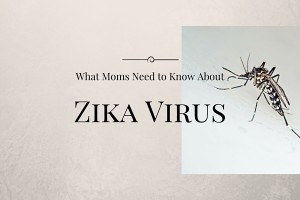Dr. Bryan Youree, a Tarrant County infectious disease physician, crafted this article to address concerns mothers have about the Zika virus and to present a general overview of the virus’ history and scope.
First, let’s start with something we know. There has been no documented case of a Zika virus (ZIKV) infection contracted by a mosquito in the United States thus far.
How Did We Get Here?
After that, the answers to many of our questions may be unknown about this virus — which nobody seems to have heard about before this calendar year. However, that doesn’t mean absolutely nothing is known about this seemingly new virus with the catchy name. So let’s take a moment to acquaint ourselves with the data reported up to this point:
- It is a flavivirus (think Dengue, Yellow Fever, West Nile).
- It is mosquito-borne (Aedes species- also good for West Nile, Dengue, and Chikungunya).
- First identified in Uganda in 1947. It gets its name from the Zika forest in Uganda.
- Serologic evidence (evidence of previous disease discovered by means of bloodwork) of human ZIKV infection was demonstrated in several African countries, India, Malaysia, Philippines, Indonesia, and Thailand during the next 34 years.
- The first documented outbreak occurred in Micronesia in 2007. Seventy three percent of the population older than three years old was estimated to have been infected. Interestingly, the virus was not detected in any mosquitoes on the island during the outbreak.
- The first documented case of ZIKV infection transmitted through sexual contact occurred in 2009 when the spouse of an infected returning traveler became infected while residing in Colorado.
- In 2014-2015, a large ZIKV outbreak took place in French Polynesia and spread to other Pacific Islands.
- The first documented perinatal transmission of ZIKV occurred during the French Polynesia outbreak. The two newborns had good outcomes.
- The first reports of ZIKV in Brazil occurred in early 2015. Genetic studies demonstrated the closest relative to the Brazil strain of the virus was isolated in the samples of patients in the French Polynesia outbreak.
- An interesting side note: Introduction to Brazil likely occurred during the August 2014 Va’s World Sprint Championship canoe race in which several Pacific countries competed. No ZIKV-endemic countries competed in the World Cup soccer competition held in Brazil in 2014.
- By mid-January 2016, ZKIV transmission had been reported in 20 countries or territories within the Americans.
- On February 1, 2016, the World Health Organization declared Zika virus and its possible link to birth defects an international public health emergency.
Why Is This Different?
What’s so concerning about the current ZIKV outbreak is that it is so much larger and possibly different. Brazil has noted a significant increase in the number of infants born with microcephaly at the same time the virus is spreading rapidly throughout the country. Guillain-Barre syndrome has been reported in some patients following a suspected ZIKV infection. However, this has not been described in previous outbreaks. It is estimated that 80 percent of infected individuals have no symptoms, while those that do often have a mild disease with fever, rash, joint pain, and conjunctivitis (eye inflammation) most commonly described. Severe disease is rare, while fatalities are even rarer.
 Is this outbreak different? ZIKV genetic material has been identified in the tissues of some infants born with microcephaly and from fetal losses. Is this enough to make a direct link, or was the virus coincidentally there and the birth defect was due to other causes? Could the virus in combination with another factor be the culprit? If there is a direct link between microcephaly and ZIKV infection, at what stage of pregnancy is infection most serious? Not enough is known at this point. Likewise, it is not clear at this point whether the incidence of Guillain-Barre syndrome is higher than the natural epidemiologic variation seen. However, there is enough observational data to raise international concern and extend extra energy and focus on these unprecedented events. It’s certainly scary times when a new disease is on the doorstep of your country, but it is important to remind ourselves of what is known about a disease and remember that anything else is speculation until proven otherwise.
Is this outbreak different? ZIKV genetic material has been identified in the tissues of some infants born with microcephaly and from fetal losses. Is this enough to make a direct link, or was the virus coincidentally there and the birth defect was due to other causes? Could the virus in combination with another factor be the culprit? If there is a direct link between microcephaly and ZIKV infection, at what stage of pregnancy is infection most serious? Not enough is known at this point. Likewise, it is not clear at this point whether the incidence of Guillain-Barre syndrome is higher than the natural epidemiologic variation seen. However, there is enough observational data to raise international concern and extend extra energy and focus on these unprecedented events. It’s certainly scary times when a new disease is on the doorstep of your country, but it is important to remind ourselves of what is known about a disease and remember that anything else is speculation until proven otherwise.
What to Know?
- Transmission: via mosquitoes, blood transfusions, sexual contact, intrauterine, and at birth (ZIKV has been detected in saliva, urine, breast milk, and semen).
- Symptoms: fever, rash, joint pain, and conjunctivitis (similar to Dengue and Chikungunya) lasting up to one week.
- Onset: within two weeks of infection.
- Diagnosis: by symptoms (no commercially available test, but expect multiple state labs to be ready before summer 2016).
- Treatment: none available; supportive care includes fluids, rest, and analgesics (avoid aspirin and ibuprofen until Dengue ruled out).
Prevention:
- No vaccine available at this time.
- If infected, avoid mosquitoes for several days to decrease risk of local transmission.
- Wear long sleeves and pants and use insect repellants when outdoors.
- On February 5, 2016, the CDC recommended that men who “reside in or have traveled to an area of active Zika virus transmission who have a pregnant partner should abstain from sexual activity or consistently and correctly use condoms during sex.”
- If you are pregnant or expect to become pregnant this year, please consult the CDC recommendations.
Bryan Youree, MD, is an infectious disease physician with the Tarrant County Infectious Disease Associates in Fort Worth, Texas. He has worked in the infectious disease field for 12 years. He attended Baylor College of Medicine and completed his post-graduate training at Vanderbilt University Medical Center. He served on faculty there before joining the Fort Worth practice.













